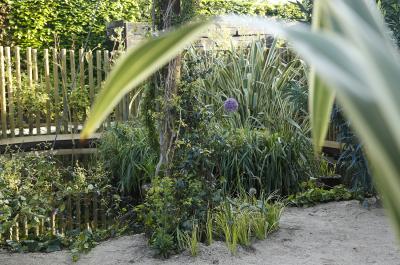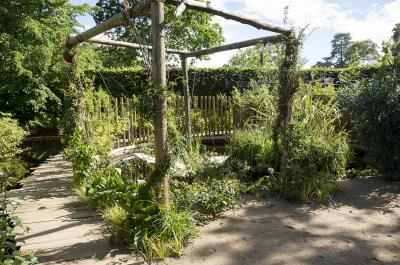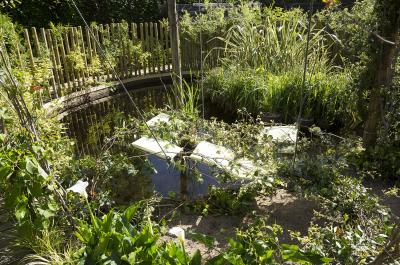03. QUAND L’AVARE RÊVE
To hoard money is to postpone the pleasure that could be enjoyed today to tomorrow. The gardener, for his part, although preparing for the (long-term) future, seeks to enjoy the present of the place that he has designed for his own happiness, as well as for his friends' happiness. The garden Quand l’avare rêve presents this duality of the accumulation of pleasure by means of a dramatised path.
It opens with the first manifestation of a rough, unpleasant miser. A clinging, desperate miser. The thistle, a thorny being that you cannot free yourself from without leaving behind a part of you. The path then evokes some of the miser's most well known features, such as his insensitivity. Just like these tree torsos, coiled into themselves, he is completely deformed and twisted. From the saprophyte family, huddled around the slightest drop of water, this grasping miser is always on guard, prepared to flee at any minute, his suitcase packed.
Once at the bottom of the plot, the path, curving to the left, leads visitors to pass through a curtain unveiling the other side of the miser; his dream. Not when he sleeps, but when he begins to devour his stash of gold - his one and only, giddy love - with his eyes.
Then, visitors walk over the water of a pond. To the right, the infinite horizon of a carpet of green water (duckweed and similar plants). To the left, the aquatic abundance of a luxury-filled space evoking the Garden of Eden and its inexhaustible fountain of youth. An indulgent bed, surrounded by delicate aromas (roses, jasmine, lemon balm, etc.) invites visitors to gaze upon a pile of golden flowers and take delight in them.
However, will the miser ever be rewarded for his sacrifices? Hanging over the bed, a plaque reminds him that "he who counts misses the point"...
DESIGNERS

From left to right: Pierre-Alexandre Risser, Vincent Vallé, Patrick Lamarque, Christine Noiville and Jasmina Davies
Pierre-Alexandre Risser has become known for overcoming the limitations of urban gardens to create oases of greenery which inspire a desire to live in harmony with nature throughout the year. Recognised as the specialist in Parisian gardens, he also designs gardens of all sizes all over the world and creates temporary gardens and plant installations for top companies. Near Paris, at the edge of Montmorency forest are his private garden, his nursery and the Horticulture & Jardins showroom. Here, customers and visitors discover the latest trends over 300 m2 of exhibitions and select their plants grown in an environmentally-friendly way. Moreover, for more than ten years, Pierre-Alexandre Risser has been co-organiser of the event "Jardins, Jardins" at the Tuileries. This show has become known as the garden and outdoor design event in the heart of Paris. He is also member of the "Carré des Jardiniers" jury of the show Paysalia. Furthermore, Pierre-Alexandre Risser is the author of many publications on gardening: "Le Jardin Plaisir de Pierre-Alexandre ", "Les Jardins à vivre de Pierre-Alexandre Risser", "Transformer son petit jardin ou sa terrasse", "Un beau Jardin au fil des saisons", "Terrasses et Balcons en ville", "Un Jardin en ville", etc.
At the age of 21, Vincent Vallée, then a young graduate, fulfilled his childhood dream, setting up his own landscaping company. He designed natural gardens, soon introducing ponds into his creations. There is a fine line between a pond and a swimming pool. A perfectionist, he developed several biological filtration systems to treat the water in his installations. At the same time, his field experience provided him with engineering construction skills, and the ability to design, among others, off the ground biological swimming pools, to install the first heated and covered biological swimming pool, and to be the pioneer of airlift pumping. For him, natural swimming pools are true sources of well being; that is why he creates them everywhere, even in the centre of Paris. Drawing on this unique know-how, Vincent Vallée is today the leading company in France for creating biological swimming pools installed, from the design stage to diving in.
Brought up on the banks of the Loire not far from Chaumont, Christine Noiville is a legal practitioner and research director at CNRS (the French National Centre for Scientific Research). A specialist in the relationship between law and scientific progress, she has written a number of books and articles on risk, the precautionary principle, genetics, GMOs and scientific expertise. She leads a research centre at the Sorbonne and chairs the Economic, ethical and social committee of the High Commission on biotechnology, the authority which advises the French government regarding biotechnology. In her other lives, she has three passions: travelling, painting (she has illustrated several children's books with Actes Sud) and, obviously, gardening. As far back as she can remember, her childhood was basked in her parents' love for plants, wild and cultivated alike. Her own garden is in Varengeville-sur-mer in Pays de Caux, where some of the most beautiful gardens in France are to be found, as well as the worldwide hydrangea collection. It is here that she prunes, hoes, takes cuttings, plants, pots and aerates her soul.
Born and raised in France, Jasmina Davies now shares her time between her family in Paris and the Laikipia Plateau in northern Kenya. Jasmina studied horticulture at the University of Hadlow in Great Britain before graduating with a landscaping degree from the University of Greenwich in London. Following a reurbanisaton project in Moscow, she worked in London for the famous British landscaper Arabella Lennox-Boyd, then at Mitchell’s & Associates in Dublin. Since then, she has worked regularly on a variety of projects, from the restoration of historical gardens for castles in Europe, landscaping for luxury hotels in the African savannah and modern terraces in cities. Since her first collection with Pierre-Alexandre Risser for "Elle Decoration" in "L'Art du Jardin" in Paris in 1992, she has created gardens for "L’Art du Jardin", "Jardin Jardin" and "La fête des plantes" at the Domaine de Courson.
Patrick Lamarque pays close attention to shapes, to structure and to light. The issues of signs and public space have fed him in the to-and-fro of his travels. Through some twenty essays on contemporary art and philosophy, he is a perfectionist of words in between his career at the ENA and his different roles with the State. The image, graphic design and the discourse of the empty and the full drive him. While curating exhibitions, which he does a lot, he has developed an intimate relationship with certain works which are, for him, a mental source which he has long shared with the woman who accompanies him in life. Design is another of his areas of curiosity, which can be seen through a series of commissions to many leading designers. Since the eighties, he has experimented with photography, his camera always on standby - a camera which he has blocked the flash of, owing to his penchant for shade. Recently, he has been looking the world over for unique trees, old wise beings whose deep voices he listens to. Their advice helps him even with his professional coaching activities and his writing, which he does whenever he has a spare moment, in the city centre, in a garden designed and created by Vincent Dupont-Rougier.



